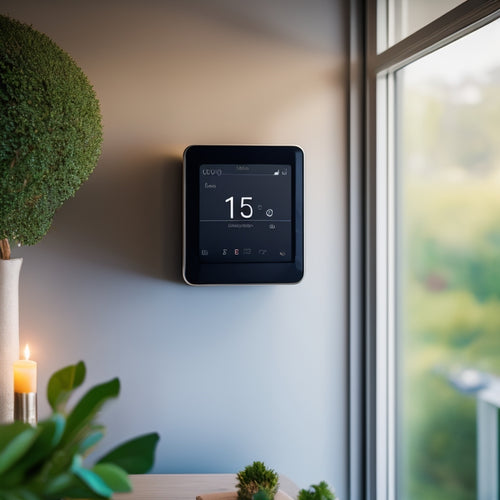
10 Tips for Greening Your Fleet With Solar Solutions
Share
You're evolving your fleet to a more sustainable future by harnessing the power of solar energy. To get started, assess your fleet's energy needs, identifying areas where solar power can be implemented. Choose efficient solar panels and reliable inverters, and consider energy storage solutions. Develop a plan to optimize energy usage, and implement a solar maintenance plan to guarantee peak performance. Monitor your fleet's energy usage, optimizing solar panel placement and adjusting your strategy as needed. A well-planned fleet-wide green strategy will help you achieve your sustainability goals. Now, uncover the specific steps to turn your vision into a reality.
Key Takeaways
• Evaluate current energy consumption patterns of fleet vehicles to identify areas where solar power can be implemented.
• Choose high-efficiency solar panels (>20%) with durability and warranty for reliable energy generation.
• Pair solar panels with reliable energy storage solutions to ensure steady power supply during no sunlight periods.
• Develop a holistic green strategy integrating solar solutions with eco-friendly initiatives, such as fuel-efficient vehicles and driver training.
• Regularly inspect and maintain solar panels, inverters, and wiring to optimize energy output and reduce losses.
Assess Your Fleet's Energy Needs
To determine the feasibility of integrating solar solutions into your fleet, start by evaluating your vehicles' current energy consumption patterns and identifying areas where solar power can make a significant impact. This fleet analysis will help you understand your energy needs and pinpoint opportunities for solar energy to reduce your reliance on fossil fuels.
Conducting an energy audit is an essential step in this process. You'll need to gather data on your vehicles' energy usage, including the types and quantities of fuel consumed, as well as the distances and frequencies of your routes. This information will enable you to identify areas where solar power can be effectively integrated, such as powering auxiliary systems or recharging batteries.
Choose the Right Solar Panels
With your fleet's energy needs assessed, you're now ready to select the right solar panels that can efficiently harness the sun's energy and meet your vehicles' power requirements. Choosing the right solar panels is essential to guarantee efficient energy harvesting and safety.
When selecting solar panels, consider the following key factors:
-
Panel Efficiency: Look for panels with high efficiency rates (above 20%) to maximize energy output. Higher efficiency means more power per unit area, reducing the number of panels needed.
-
Material Durability: Ensure the panels are built with durable materials that can withstand harsh environmental conditions, such as extreme temperatures, humidity, and physical stress.
-
Warranty and Certification: Opt for panels with a thorough warranty (at least 25 years) and certifications from reputable organizations, such as UL (Underwriters Laboratories) or IEC (International Electrotechnical Commission), to guarantee safety and performance.
Consider Energy Storage Options
You'll need to pair your solar panels with a reliable energy storage system to guarantee a steady power supply for your fleet, even when the sun isn't shining. This is essential, as solar power generation can be intermittent.
A well-designed energy storage system will make certain that your fleet's power needs are met consistently. When selecting an energy storage solution, consider the battery life and its impact on your overall system. A longer battery life means fewer replacements, reducing costs and environmental waste.
Additionally, consider grid connection options, which enable you to feed excess energy back into the grid and offset your energy consumption during periods of low solar generation. This approach not only enhances your fleet's sustainability but also provides a potential revenue stream.
Select the Best Inverters Available
Your solar-powered fleet relies on high-quality inverters to convert DC power from the solar panels into usable AC power, making it essential to select the best inverters available that can efficiently handle the energy demands of your fleet.
When selecting an inverter, you'll want to take into account the following key factors to guarantee peak performance and safety:
-
Inverter efficiency: Look for inverters with high efficiency ratings (above 95%) to minimize energy losses during power conversion.
-
Power conversion capacity: Choose an inverter that can handle the maximum power output of your solar panels, ensuring that you can harness the full potential of your solar energy system.
-
Certifications and compliance: Verify that the inverter meets relevant safety and performance standards, such as UL and IEEE certifications, to secure safe and reliable operation.
Plan for Energy Efficiency
By optimizing energy usage across your fleet, you can greatly reduce energy waste and maximize the benefits of your solar-powered fleet. To achieve this, consider conducting energy audits to identify areas of inefficiency and opportunities for improvement. This assessment will help you pinpoint where energy is being wasted and provide valuable insights on how to optimize your fleet's energy consumption.
As you plan for energy efficiency, it's vital to explore fuel alternatives that can help reduce your fleet's reliance on fossil fuels. Solar power is an excellent option, but you may also want to contemplate other alternatives like biofuels, hydrogen fuel cells, or even electric vehicles. By diversifying your fuel sources, you can lessen your fleet's carbon footprint and minimize its impact on the environment.
When planning for energy efficiency, it's crucial to set clear goals and benchmarks to measure your progress. Establish a baseline for your fleet's current energy consumption and set targets for reduction. With a well-planned energy efficiency strategy, you can significantly reduce energy waste, lower operating costs, and contribute to a more sustainable future.
Reduce Your Fleet's Carbon Footprint
As you work to reduce your fleet's carbon footprint, you'll want to focus on lowering emissions output to minimize your environmental impact.
You can achieve this by exploring eco-friendly fleet options that prioritize sustainability.
Lower Emissions Output
Minimizing emissions output is crucial for fleets, since transportation is one of the largest contributors to greenhouse gas emissions, with the average fleet vehicle emitting around 10,000 kilograms of CO2 per year. As a fleet operator, you play a crucial role in reducing your carbon footprint. By implementing fuel-efficient practices and leveraging government incentives, you can greatly lower your emissions output.
Here are three ways to get started:
-
Optimize your routes: Plan your routes in advance to reduce fuel consumption and lower emissions. You can use route optimization software to find the most efficient routes.
-
Invest in fuel-efficient vehicles: Consider replacing old vehicles with newer, fuel-efficient models. You can also explore alternative fuel options, such as electric or hybrid vehicles.
-
Take advantage of government incentives: Many governments offer incentives for fleets that adopt eco-friendly practices. Research and take advantage of these incentives to offset the cost of shifting to a more sustainable fleet.
Eco-Friendly Fleet Options
You can choose from a range of eco-friendly fleet options to substantially reduce your fleet's carbon footprint, from solar-powered systems to alternative fuel vehicles. By incorporating these sustainable solutions, you'll not only minimize your environmental impact but also benefit from potential cost savings and improved brand reputation.
One effective way to green your fleet is by exploring fuel alternatives, such as electric vehicles (EVs), hybrid vehicles, or those powered by compressed natural gas (CNG) or liquefied petroleum gas (LPG). These alternatives can greatly reduce greenhouse gas emissions and dependence on fossil fuels.
In addition to alternative fuel vehicles, you can also adopt sustainable logistics practices, such as optimizing routes, reducing idle time, and implementing efficient delivery schedules. By streamlining your logistics operations, you can lower emissions, reduce fuel consumption, and improve overall fleet efficiency.
Implement a Solar Maintenance Plan
Regularly inspecting and maintaining your solar-powered fleet's energy systems guarantees peak performance, extends equipment lifespan, and reduces downtime. By implementing a solar maintenance plan, you'll ensure your fleet operates efficiently and safely. This proactive approach helps prevent costly repairs, minimizes energy losses, and reduces the risk of accidents.
To maintain your solar-powered fleet, follow these preventive measures:
-
Regular Inspections:
Schedule regular checks to identify and address potential issues before they escalate. Inspect solar panels, inverters, and wiring for signs of wear, damage, or malfunction. -
Cleanliness is Key:
Regularly clean solar panels to ensure optimal energy absorption. Dirt, dust, and debris can have a significant impact on energy output, so cleaning is essential for peak performance. -
Tighten Loose Connections:
Verify that all electrical connections are secure and tightened properly. Loose connections can lead to energy losses, overheating, and even electrical fires.
Monitor Your Fleet's Energy Usage
By keeping a close eye on your fleet's energy usage, you'll be able to identify areas of inefficiency and optimize your solar-powered systems for maximum performance. Conducting regular energy audits can help you pinpoint energy-wasting habits and behaviors within your fleet. This will enable you to develop targeted strategies for improvement, reducing your carbon footprint and boosting fuel efficiency.
Monitor your fleet's energy consumption patterns to identify opportunities for reduction. Analyze your vehicles' energy usage, taking into account factors like route optimization, driver behavior, and vehicle maintenance. This data will help you identify areas where energy is being wasted and provide valuable insights for improvement.
Optimize Your Solar Panel Placement
Properly positioning your solar panels can greatly enhance their energy output, so it's crucial to assess your fleet's roof space and identify the best placement for maximum energy harnessing.
To optimize your solar panel placement, consider the following key factors:
-
Panel Angles: Adjust the angle of your solar panels to match the orientation of your fleet's roof. This guarantees the panels receive the best amount of sunlight and energy output.
-
Shading Analysis: Conduct a shading analysis to identify areas on your fleet's roof that may be obstructed by shadows, such as from trees or building structures. This helps you avoid installing panels in areas with reduced energy output.
-
Roof Obstacles: Take note of any roof obstacles, such as vents, skylights, or antennas, that may affect the placement of your solar panels. Plan your installation around these obstacles to establish a safe and efficient energy-harvesting system.
Develop a Fleet-Wide Green Strategy
With a solid foundation in solar panel placement, you can now develop a holistic fleet-wide green strategy that integrates solar solutions with other eco-friendly initiatives to maximize your environmental impact. This strategy should be guided by Green Leadership, which fosters a Sustainable Culture within your organization.
To develop an effective strategy, consider the following key elements:
| Element | Description | Benefits |
|---|---|---|
| Fuel Efficiency | Implement fuel-efficient vehicles and driver training | Reduced emissions, lower fuel costs |
| Alternative Fuels | Explore alternative fuel options, such as electric or hybrid vehicles | Lower emissions, reduced dependence on fossil fuels |
| Route Optimization | Implement route optimization software to reduce miles driven | Lower emissions, reduced fuel costs |
| Vehicle Maintenance | Regular maintenance to make sure vehicles are running efficiently | Reduced emissions, reduced fuel costs |
| Driver Incentives | Offer incentives for drivers to adopt eco-friendly driving habits | Encourages sustainable behavior, reduced emissions |
Frequently Asked Questions
Can I Install Solar Panels on All Types of Fleet Vehicles?
You can install solar panels on most fleet vehicles, but it depends on vehicle compatibility. Make sure panels are securely attached and strategically placed to avoid obstructing driver visibility, maintaining safety while harnessing renewable energy.
Are Solar Solutions Compatible With Existing Fleet Management Software?
"You're not stuck in the dark ages, wondering if solar solutions will clash with your existing fleet management software. Fear not, as most solar solutions seamlessly integrate with your current system, ensuring data integration and system compatibility, so you can drive into a sustainable future with confidence."
How Do I Ensure Solar Panels Don't Obstruct Driver Visibility?
When installing solar panels, it's important to make sure they don't obstruct driver visibility. Opt for strategic panel placement, and conduct thorough visibility testing to guarantee a safe driving experience, avoiding blind spots and potential hazards.
Can Solar Panels Be Used in Conjunction With Other Alternative Fuels?
"You're not limited to just solar power; you can combine it with alternative fuels like biofuels, hydrogen, or natural gas through fuel blending, achieving energy diversification and a more sustainable fleet operation."
Are There Any Government Incentives for Fleets Transitioning to Solar?
You'll be pleased to know that, yes, government incentives are available for fleets shifting to solar. You can capitalize on tax credits and renewable grants to offset the cost of solar integration, making the switch more affordable and environmentally friendly.
Related Posts
-

Smart Energy: Greener Homes With Connected Power Devices
You can control and optimize your energy consumption with smart energy devices, reducing your carbon footprint by up ...
-

Why Biodegradable Dish Soap Matters for Earth-Conscious Homes
You likely don't realize that the dish soap you're using today will still be harming the environment long after you'v...
-

7 Top HEPA Filters for Green Building Projects
You need a reliable HEPA filter for your green building project that aligns with your sustainable goals and guarantee...


